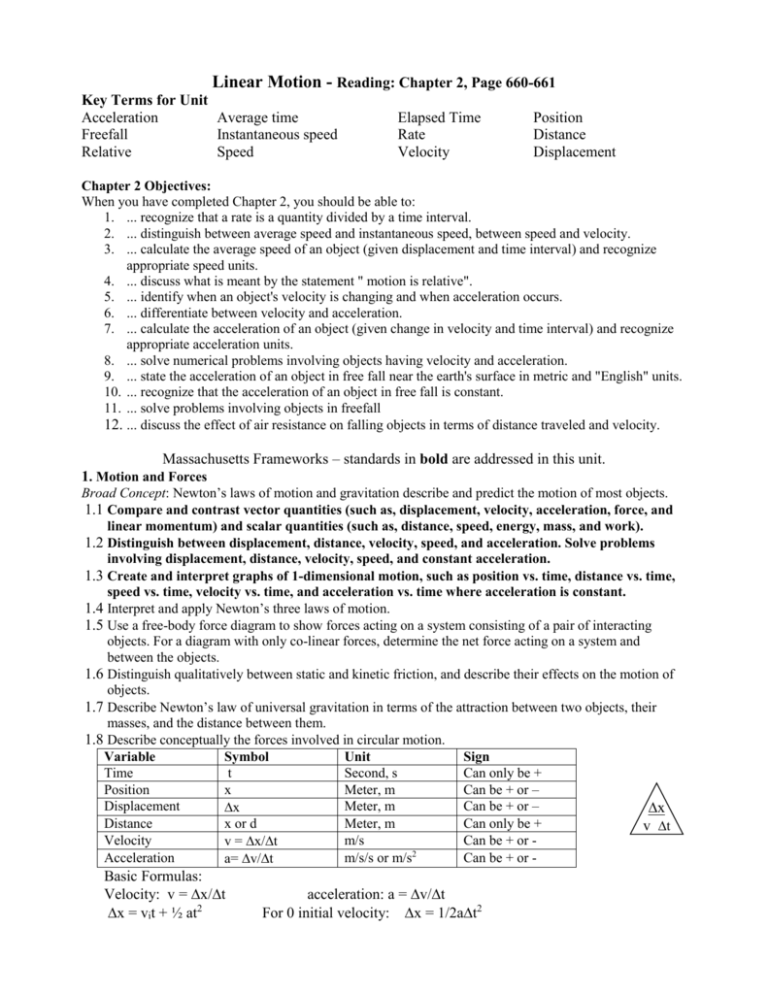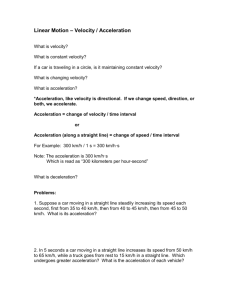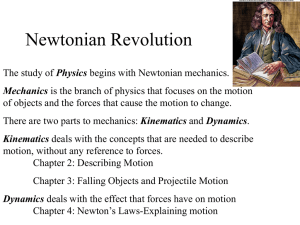Linear Motion Study Guide: Key Terms, Formulas, Objectives
advertisement

Linear Motion - Reading: Chapter 2, Page 660-661 Key Terms for Unit Acceleration Average time Elapsed Time Position Freefall Instantaneous speed Rate Distance Relative Speed Velocity Displacement Chapter 2 Objectives: When you have completed Chapter 2, you should be able to: 1. ... recognize that a rate is a quantity divided by a time interval. 2. ... distinguish between average speed and instantaneous speed, between speed and velocity. 3. ... calculate the average speed of an object (given displacement and time interval) and recognize appropriate speed units. 4. ... discuss what is meant by the statement " motion is relative". 5. ... identify when an object's velocity is changing and when acceleration occurs. 6. ... differentiate between velocity and acceleration. 7. ... calculate the acceleration of an object (given change in velocity and time interval) and recognize appropriate acceleration units. 8. ... solve numerical problems involving objects having velocity and acceleration. 9. ... state the acceleration of an object in free fall near the earth's surface in metric and "English" units. 10. ... recognize that the acceleration of an object in free fall is constant. 11. ... solve problems involving objects in freefall 12. ... discuss the effect of air resistance on falling objects in terms of distance traveled and velocity. Massachusetts Frameworks – standards in bold are addressed in this unit. 1. Motion and Forces Broad Concept: Newton’s laws of motion and gravitation describe and predict the motion of most objects. 1.1 Compare and contrast vector quantities (such as, displacement, velocity, acceleration, force, and linear momentum) and scalar quantities (such as, distance, speed, energy, mass, and work). 1.2 Distinguish between displacement, distance, velocity, speed, and acceleration. Solve problems involving displacement, distance, velocity, speed, and constant acceleration. 1.3 Create and interpret graphs of 1-dimensional motion, such as position vs. time, distance vs. time, speed vs. time, velocity vs. time, and acceleration vs. time where acceleration is constant. 1.4 Interpret and apply Newton’s three laws of motion. 1.5 Use a free-body force diagram to show forces acting on a system consisting of a pair of interacting objects. For a diagram with only co-linear forces, determine the net force acting on a system and between the objects. 1.6 Distinguish qualitatively between static and kinetic friction, and describe their effects on the motion of objects. 1.7 Describe Newton’s law of universal gravitation in terms of the attraction between two objects, their masses, and the distance between them. 1.8 Describe conceptually the forces involved in circular motion. Variable Symbol Unit Sign Time t Second, s Can only be + Position x Meter, m Can be + or – Displacement Meter, m Can be + or – x x Distance x or d Meter, m Can only be + v t Velocity m/s Can be + or v = x/t Acceleration m/s/s or m/s2 Can be + or a= v/t Basic Formulas: Velocity: v = x/t x = vit + ½ at2 acceleration: a = v/t For 0 initial velocity: x = 1/2at2









